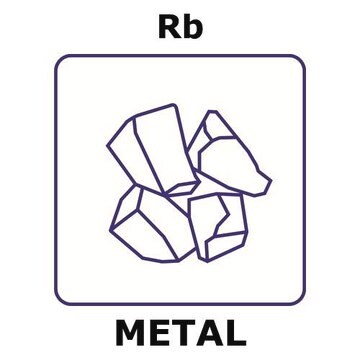This material is not specifically isolated or tested for the presence of specific isotopes. The naturally occurring ratio of each is approximately 72% stable isotope 85Rb, and 28% slightly radioactive 87Rb. This product is expected to have the same or a similar profile.
276332
Rubidium
ingot, 99.6% trace metals basis
About This Item
Prodotti consigliati
Livello qualitativo
Saggio
99.6% trace metals basis
Stato
ingot
Impiego in reazioni chimiche
reagent type: reductant
Confezionamento
pkg of Packaged in: Breakseal Ampule
Resistività
11.0 μΩ-cm, 20°C
Impurezze
0.2-0.4% Cs
P. ebollizione
686 °C (lit.)
Punto di fusione
38-39 °C (lit.)
Densità
1.53 g/mL at 25 °C (lit.)
Stringa SMILE
[Rb]
InChI
1S/Rb
IGLNJRXAVVLDKE-UHFFFAOYSA-N
Cerchi prodotti simili? Visita Guida al confronto tra prodotti
Categorie correlate
Descrizione generale
Applicazioni
It can also be used as a reducing agent to synthesize reduced polycyclic aromatic hydrocarbons.
Avvertenze
Danger
Indicazioni di pericolo
Consigli di prudenza
Classi di pericolo
Eye Dam. 1 - Skin Corr. 1B - Water-react 1
Rischi supp
Codice della classe di stoccaggio
4.3 - Hazardous materials which set free flammable gases upon contact with water
Classe di pericolosità dell'acqua (WGK)
WGK 3
Punto d’infiammabilità (°F)
Not applicable
Punto d’infiammabilità (°C)
Not applicable
Dispositivi di protezione individuale
Eyeshields, Faceshields, Gloves, type P3 (EN 143) respirator cartridges
Scegli una delle versioni più recenti:
Possiedi già questo prodotto?
I documenti relativi ai prodotti acquistati recentemente sono disponibili nell’Archivio dei documenti.
I clienti hanno visto anche
-
We are interested in purchasing a rubidium ingot (product no. 276332-1G). Could you please confirm if this is of natural abundance Rb or enriched 85Rb? I will provide all the necessary details for a quotation once I hear back from you. Thank you.
1 answer-
Helpful?
-
-
Are the Rubidium ingots (276332-1G) that you deliver in an ampule, stored in vacuum or in an inert gas?
1 answer-
This product is packaged in sealed ampules under an Argon.
Helpful?
-
Active Filters
Il team dei nostri ricercatori vanta grande esperienza in tutte le aree della ricerca quali Life Science, scienza dei materiali, sintesi chimica, cromatografia, discipline analitiche, ecc..
Contatta l'Assistenza Tecnica.












